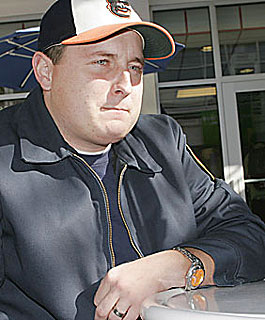 |
|
VAN CARAVELLI/Arizona Daily Wildcat
|
David Horner, who was diagnosed with testicular cancer last year, is now recovering thanks to UMC's new shape-beam radiosurgery system.
|
|
|
By Natasha Bhuyan
Arizona Daily Wildcat
Thursday, December 2, 2004
Print this
When David Horner found out he had testicular cancer last year, he braced himself for the worst.
"I thought, 'I'm going to die - am I ready to die?'" Horner said. "Everything came to a standstill."
But after two surgeries, a month of chemotherapy and a state-of-the-art radiosurgery treatment, Horner, a 25-year-old doctoral student of pharmacology, is on the road to recovery.
Horner was the fourth patient in Tucson to receive treatment from a new shaped-beam radiosurgery system purchased by University Medical Center last month.
The $3 million Novalis Shaped Beam Surgery system, manufactured by the medical technology company BrainLAB, uses computer-generated images to get an accurate depiction of the patient's tumor. It then delivers radiation which conforms to the exact shape and size of the tumor.
Dr. Baldassarre Stea, head of the radiation oncology department and a clinical medical director for radiation oncology at the UA, said since the radiation is delivered at angles to precisely target the tumor, healthy tissues surrounding the tumor are not damaged, minimizing the chance of side effects.
"We are able to treat patients that otherwise would be difficult to help because it would be too risky," Stea said. "You need a stable machine with precision to the thickness of a paper."
Horner said he opted for the shaped-beam radiation treatment after learning conventional radiation had a higher risk of brain damage.
Horner said a friend of his who received conventional radiation was unable to read books because when he reached the end of a page, he forgot what was written at the top.
"In my line of work, what would I do?" said Horner, an aspiring pharmacologist.
But Horner, who had tumors in his lungs and a golf-ball sized tumor in his brain as a result of his testicular cancer, said of all his treatments, radiosurgery was the easiest procedure.
"It took about 45 minutes," Horner said. "I slept through most of it - you don't feel a thing."
Dr. Abhay Sanan, clinical assistant professor in the surgery department, said patients may stay awake for the procedure, and radiosurgery eliminates lengthy hospital stays or rehabilitation.
In some cases, radiosurgery may be the only option and is a much safer choice than conventional surgery, Stea said.
Vascular malformations, where blood vessels are malformed at birth, require radiosurgery because a conventional brain surgery could result in heavy bleeding.
UMC decided to purchase the Novalis machine after using a prototype machine for 11 years. However, that machine became obsolete in 2000 so UMC began exploring other radiosurgery options. Because there is a "huge need" for radiation technology in Southern Arizona, Stea said UMC purchased the system last month.
To date, three to four patients have been treated at UMC with the shaped-beam per day, and there is a waiting list for the outpatient procedure.
"Before, we used to send patients to Phoenix," Stea said. "Now, all of a sudden, we can offer Tucson and southern Arizona the same technology that was only available at UCLA or USC."
Although it may be months or years until a tumor is gone for sure, Stea said the effects of the radiosurgery can be instantaneous.
"It depends on the situation: One patient had been in pain for three years," Stea said. "After (the radiosurgery), he got out of the table and was pain-free within an hour."
For Horner, doctors said he will be "in the clear" after six months. Until then, Horner said he will continue with his life and appreciate what he's learned from the experience.
"I've learned how much I'm loved, especially by my wife," said Horner. "And you learn to live with the unknown."
